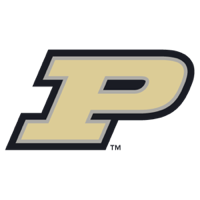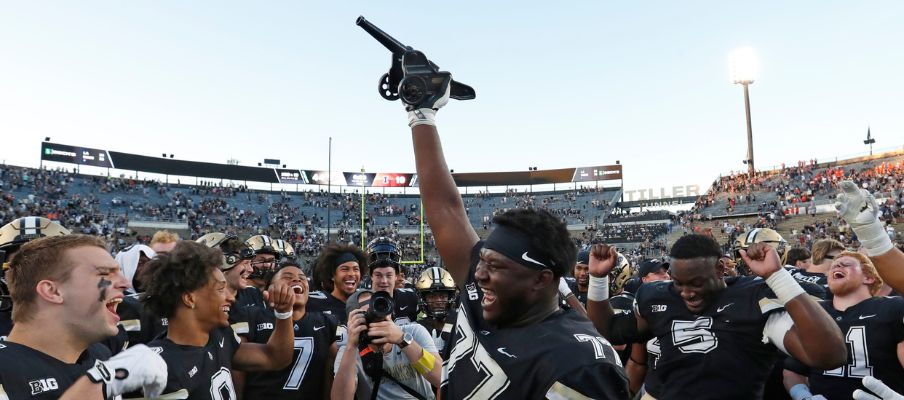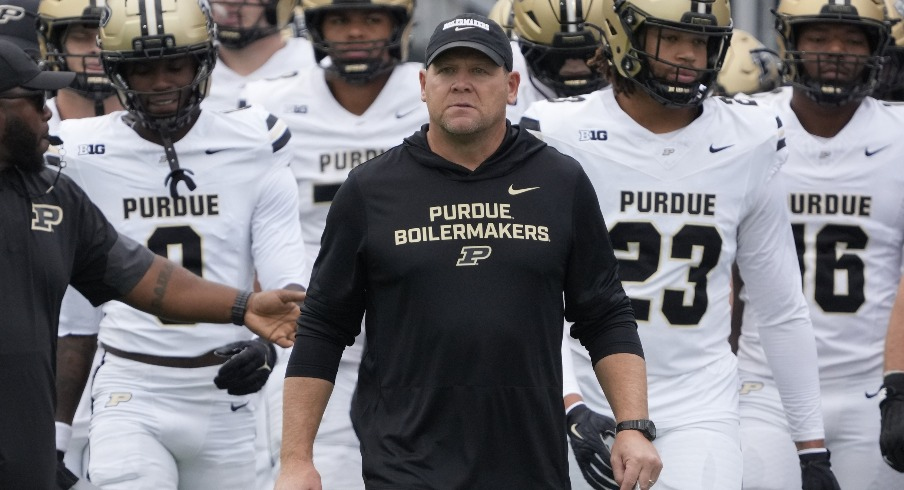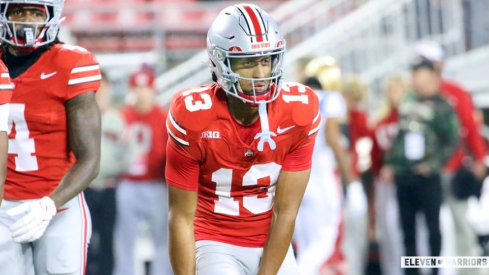With the Penn State game in Ohio State’s rearview mirror, The Game looms ever more present in the background of the Buckeyes’ season like an ominous church clock tower. Three lackluster opponents remain before the hour arrives for Michigan week.

The first of the three is a road trip to Purdue. While scars remain for fans after the Boilermakers spoiled Ohio State’s College Football Playoff ambitions in Ross-Ade Stadium in 2018, the Buckeyes have won each of their three meetings with Purdue in the Ryan Day era, and all by at least four touchdowns. That includes a 41-7 win on the road in 2023 and a 45-0 drubbing in 2024.
Purdue provided an upset threat as recently as 2022, when they were stringing together some eight-win seasons under Jeff Brohm, but now Brohm is at Louisville and the Boilermakers are on their second head coach since his departure. Ryan Walters, his replacement, followed a 4-8 first year with a 1-11 second year and the termination of his contract.
Now coached by former UNLV showrunner Barry Odom, it’s a complete rebuilding season for Purdue, which is off to a 2-7 start and still searching for its first Big Ten win. There isn’t much that’s impressive about the Boilermakers on either side of the ball, but still a few threats, and Ohio State can’t afford to take any conference road opponent lightly. Until the Buckeyes show a slip in focus in one of these games, though, Five Things to Know isn’t in the business of drumming up fear about a team on a seven-game losing streak. But Purdue is also a tradition-rich program with some fun history to discuss.
They Stink
This is the lone returning Thing to Know about Purdue from last year. With a new head coach, there’s always hope for the future, but there’s no hope of the Boilermakers achieving much of anything this season.
Purdue is one of two Big Ten teams currently outside the top 100 in college football for both scoring offense and scoring defense. They join UCLA in that regard, the only conference program bad enough to get both its head coach fired (Deshaun Foster) and help prompt another team’s head coach to be fired (James Franklin) during the 2025 regular season. The Boilermakers score just 22.9 points per game while allowing 30.4, which is 103rd and 106th nationally.
A major contributing factor has been turnovers. Only two of the FBS’ 136 teams have a worse turnover margin than Purdue’s -10 this year. Its quarterbacks have combined for 10 interceptions with just 13 touchdown passes, starter Ryan Browne being the biggest culprit with seven picks to go with his nine scoring tosses. The Boilermakers’ seven lost fumbles are the ninth-most in the country for good measure.
Purdue’s seven-game losing streak includes a 43-27 home loss to rival Illinois and another 16-point loss at home to USC. The Boilermakers have kept things close in recent weeks, at least, falling to fellow Big Ten bottomfeeder Rutgers 27-24 on Oct. 25 and giving Michigan’s disoriented offense a scare in a 21-16 affair on the road this past Saturday. That should be enough for Day and staff to manifest some motivation for the Buckeyes, if needed, at least.
Barry, Barry Quite Contrary
Here lies a chance to give credit to Purdue’s administrators. Hiring Walters came with plenty of risk, with him being an inexperienced first-time head coach who made his name as a defensive coordinator at Illinois. It didn’t pan out, so the Boilermakers pivoted to someone with more seasoning. Though not all of that seasoning is tasty.
Odom spent 13 years as an assistant coach at Missouri and Memphis before landing Missouri’s head coaching job in 2016. He went from four wins in his first season to eight wins in his third, but a regression to 6-6 in his fourth campaign saw the Tigers fire him and move to Eli Drinkwitz, who is now off back-to-back 10-win seasons in 2023 and 2024.
From there, Odom spent three years as Arkansas’ defensive coordinator before landing the UNLV gig. He instantly took the Rebels from five wins in 2022, the year before his arrival, to nine wins in 2023 to 11 wins and a Mountain West Championship Game appearance in 2024, taking home Mountain West Coach of the Year honors. He’s on the rise, but yet to prove himself at the Power Four level after his failures at Missouri.
Odom has expressed a clear plan to rebuild Purdue’s culture. Whether he brings one of the Big Ten’s biggest have-not programs into a competitive bunch over the next few seasons remains to be seen.
“We established 16 core values of our team and our program, and we call it the Purdue way,” Odom said at Big Ten Media Days on July 24. “And the way that we’re building our program through toughness and consistency and togetherness and teamwork and those values, it is a natural fit for Purdue football and all the great fans and donors that we have that support our university.”
A Bit of Pressure

One thing Purdue has done well this season, relative to other areas at least, is get after opposing quarterbacks. The Boilermakers are tied for 30th in the country with 21 sacks in 2025, an average of 2.3 per game.
The biggest pass-rushing threat is defensive CJ Nunnally IV. He’s racked up five sacks this season to go with 32 tackles, 7.5 tackles for loss, a pass breakup and two forced fumbles. At 6-foot-3 and 265 pounds, Nunnally plays out of a two-point stance and uses his speed and hand fighting to out-leverage offensive tackles on the rush.
Nunnally’s biggest support on the rush comes from linebackers Mani Powell and Charles Correa, who each have three sacks on the year. Powell is tied for the team lead in tackles with defensive back Tahj Ra-El at 81, with Correa trailing right behind them at 78 takedowns.
Despite the pass-rushing successes that group provides, Purdue is 91st nationally in pass defense – one spot above its run defense – allowing 234.4 passing yards per game. Julian Sayin has also been excellent at avoiding pressure when it’s been in his face this season, so the passing attack should be a huge mismatch in Ohio State’s favor in West Lafayette.
Cradle of Quarterbacks
While Purdue has never won a national championship in football, one thing the Boilermakers have done is produce great NFL quarterbacks, particularly in the last 50 years before the turn of the century. It’s been enough to earn them the nickname “Cradle of Quarterbacks.”
Bob DeMoss is the grandfather of the tradition. He quarterbacked Purdue for four years from 1945 through 1948, leading the Boilermakers to an upset victory over No. 4 Ohio State in the first of those years. He spent one year in the NFL with the New York Bulldogs (a team that existed for just five seasons under three different names in two different cities) before returning to his alma mater in 1950 to become quarterbacks coach, which he was for 20 years before becoming head coach in 1970.
DeMoss recruited and developed two of the most famous members of the cradle: Pro Football Hall of Famers Len Dawson and Bob Griese. Dawson was one of the NFL’s premier quarterbacks of the 1960s, leading the league in completion percentage seven times during that decade and leading the league in passing touchdowns four times. He led the Kansas City Chiefs to their first Super Bowl win in 1969.
Griese won two Super Bowls during a 14-year career with the Miami Dolphins, capping the NFL’s lone perfect season post-merger with one of those championships in 1972. He was an eight-time Pro Bowler, two-time first-team All-Pro and threw for more than 25,000 career yards in an era with much less passing. He often sported a large pair of glasses while playing, giving him a signature look.
But Drew Brees is the king of the cradle. After finishing his Purdue career as the Big Ten record holder for passing completions, yards and touchdowns, he launched a legendary 20-year career, the first five with the San Diego Chargers and the last 15 much more famously with the New Orleans Saints. He set the NFL’s single-season record for passing yards in 2011 (5,476), later broken by Peyton Manning. He’s one of just two quarterbacks in NFL history to throw for 80,000 career yards, joining Tom Brady.
(I wanted to include some Drew Brees career highlights here, but the NFL doesn't allow any of its content to be embedded from YouTube because it is, in fact, the No Fun League, so here is a cute documentary about the cradle from 2010 instead.)
Brees got his Super Bowl ring, the first and only in Saints history, in the 2009 season. He took home Super Bowl MVP after completing 82.1% of his passes for 288 yards and two touchdowns. He’s the NFL’s career record holder in completion percentage at 67.7%, though two active players – Cincinnati’s Joe Burrow and Miami’s Tua Tagovailoa (I know, I know, I’m shocked too) – are currently ahead of him.
Purdue is one of just two schools to produce three Super Bowl-winning quarterbacks, joining Alabama (Bart Starr, Ken Stabler and Joe Namath).
Trio of Trophies
There are three rivalry trophies that Purdue plays for against Illinois, Indiana and Notre Dame. Each carries a distinct look. Two of them date back to before World War II.
The newest of the three carries with it the least heated of the rivalries, the Shillelagh Trophy, which is for the series between Purdue and Notre Dame. A shillelagh is an Irish walking stick or club. A Fighting Irish fan named Joe McLaughlin, a seaman, donated the club in 1957 and it’s been used as the trophy for the series ever since. Notre Dame dominates the matchup with a 59-26-2 record, excluding two vacated wins from 2012 and 2013. The Fighting Irish picked up their eighth straight win over Purdue in a 56-30 drubbing this season.
Conversely, the Illinois/Purdue rivalry is one of the tightest in college football, with the Boilermakers holding a mere one-game edge after this year’s loss at 48-47-6. In 1905, a group of students took a cannon with them to Champaign, Illinois in hopes of firing it after a Boilermaker win. Purdue won, but the cannon was confiscated before the students could shoot it.
The artillery piece gathered dust in a farmhouse until 1943 when the man who confiscated it, Quincy A. Hall, recommended it as a trophy when the rivalry resumed that year following a 12-year hiatus. The two teams have dueled every year for it since, though the actual trophy they take home is a smaller replica.

The oldest of Purdue’s rivalry trophies is, fittingly, the Old Oaken Bucket, which is the trophy the Boilermakers play Indiana for. It is, as the name suggests, an old oak bucket.
The same original oak bucket has lasted the course of the rivalry, in fact it’s lasted more than 160 years, as it comes from a well in a farm settled in the 1840s. Chicago alumni groups of both schools tasked with coming up with a rivalry trophy in 1925 settled on an oak bucket, saying it would be “a most typical trophy” for two teams from Indiana. The best part about the trophy is the way it marks the rivalry’s winners.
Rather than print or etch scores into the surface somewhere as most rivalries do, when Indiana or Purdue wins, that team adds a chain link with a “P” or “I” to a string of them attached to the bucket – as if it were being lowered into or raised from the water well where it was first found. There have been 63 “P” links and 33 “I” links attached to the chain in total since the trophy’s inception, and two more “I-P” links for the two ties since that time. Purdue holds the overall edge in series history at 77-43-6.



